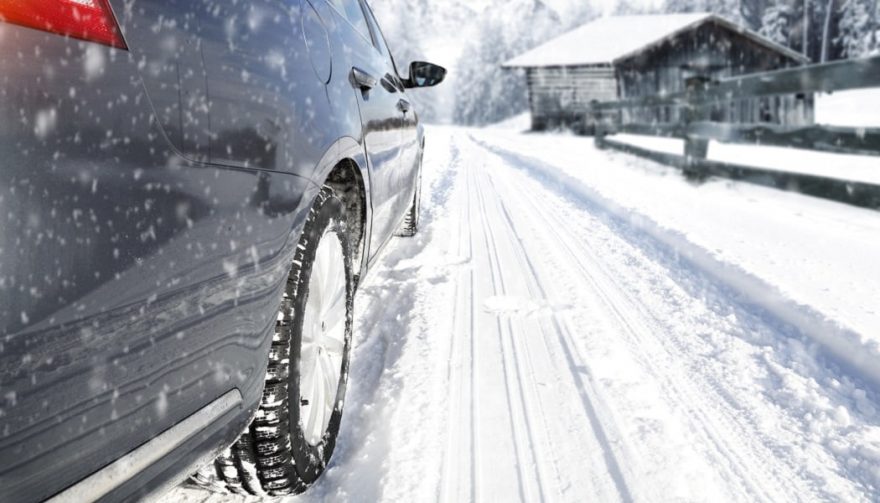
Take it slow and steady if you find yourself driving in snow
Driving in Snow? Don’t Sweat the White Stuff
Even under the best of conditions, driving in snow is risky business. According to the U.S. Department of Transportation, nearly 6,000 people will die in snow-related traffic accidents before this winter is done.
Overconfidence and a lack of prudent driving decisions are principal causes of accidents. Every time you take your vehicle out in the snow, there’s a greater chance an accident will happen.
Even if you are accustomed to driving in snow, that doesn’t mean everyone else is. And another driver’s bad driving can quickly turn into your problem. You need anticipate hazards and try to avoid them at all costs.
If you’re driving in snow, you need to maintain control of your car and to keep a keen sense of what’s going on around you. You also need to ensure that other drivers can see your car as clearly as possible.
Driving in Snow: Get the Right Tires
Let’s talk about gearing up before we get into behavior. At the heart of the challenge of driving in snow is the lack of traction between your tires and the road. Creating traction and optimizing what little traction there is goes a long way in increasing much-needed control.
Tires, be they snow tires or all-season tires, need at least 6/32-inch tread depth. The tires on high performance vehicles are pretty much worthless in snow. Because they are designed to dissipate heat, they turn rock hard in the snow and offer no traction at all.
The Tire Rack, a prominent online retailer, recommends a low-quality snow tire over the best all-season tire. Snow tires after all, are designed to go through snow. All-season tires are a bit of a misnomer. If you are going to get snow tires, get a set of four, not just two.
As helpful as snow tires are in the snow, they can be a pain on dry pavement.They are incredibly loud. And if you are driving with only two, steering is going to feel awkward.
Driving in Snow: Visibility
If you are driving in snow, visibility is important. You need to be able to see other drivers, and you need to do what you can so they can see you.
Wipers
If you can’t remember the last time you replaced your wipers, you need to do that now. If you live in an area that gets a lot of snow, get wipers designed for snow.
Clean Windshield
Thoroughly clean the inside of your windshield. When you clean the outside, use a water repellent like Rain-X. Also, make sure you have a full supply of anti-icing fluid in your windshield washer tank.
If you need to defrost the windshield, run the AC on “fresh air” mode. Many newer cars do this automatically.
Headlights
If you don’t have automatic running lights, turn on your headlamps when you’re driving in snow. It doesn’t matter what time of the day it is. Before you head out, knock any snow off your lights if there is any. If your lamp covers are cloudy, give them a wash or get new ones.
Driving in Snow: Safe Driving Habits
And now a little about good habits for driving in snow.
Don’t Drive If You Don’t Have to
The first rule is to not drive if you have the option not to. If you can wait until the streets are cleared, you’re going to be better off. Snow on the road is usually always a good excuse to postpone an engagement if you can.
Realistically, most of us can’t just take the day off and wait for the storm to pass. We have to get out in it. When we do, the objective is to try and not become a danger to others and ourselves.
Drive Slow
Keep it slow. It’s hard to stop on snow and ice. And your ECS and ABS systems help, but they can’t guarantee you will stop in a straight line when there is poor traction.
Everything you do when driving in the snow will take longer, so plan in advance and don’t try to beat the clock.
Stopping, Starting and Turning in the Snow
You will have to accelerate slower to avoid sliding. Braking will take longer because you’ll need about five times the distance needed on a dry road. Turning takes longer because of the threat of a spin out.
Don’t speed but try not to stop either. Trying to accelerate from a dead stop on snow or ice can be tricky. AAA recommends that you slow down and try to time your approach to a red light so that you never come to a complete stop before the light turns green.
Going Up a Hill
If you have to go up a hill driving in snow, put your car in a low gear before you hit the incline. This is a lot easier in a manual transmission. If you have an automatic transmission, you don’t want your car’s engine to change gears while you’re traveling up the hill. The momentary break in push will increase the chances of your tires losing traction.
Also, while you’re going up, don’t let off the gas until you reach the top.
If You Get Stuck in the Snow
If you get into a worst case scenario and find yourself on the side of the road waiting for help, don’t forget your tail pipe. You may be stopped, but odds are the snow is still coming down or being blown against your vehicle.
If you are running the engine to keep warm, you’ll want to periodically check your tail pipe to ensure it is not clogged with snow or ice. A clogged tail pipe can create a deadly atmosphere in the passenger cabin.
If you don’t have one, it’s a great idea to have a roadside emergency kit in your car. Be sure to put a blanket in there.





